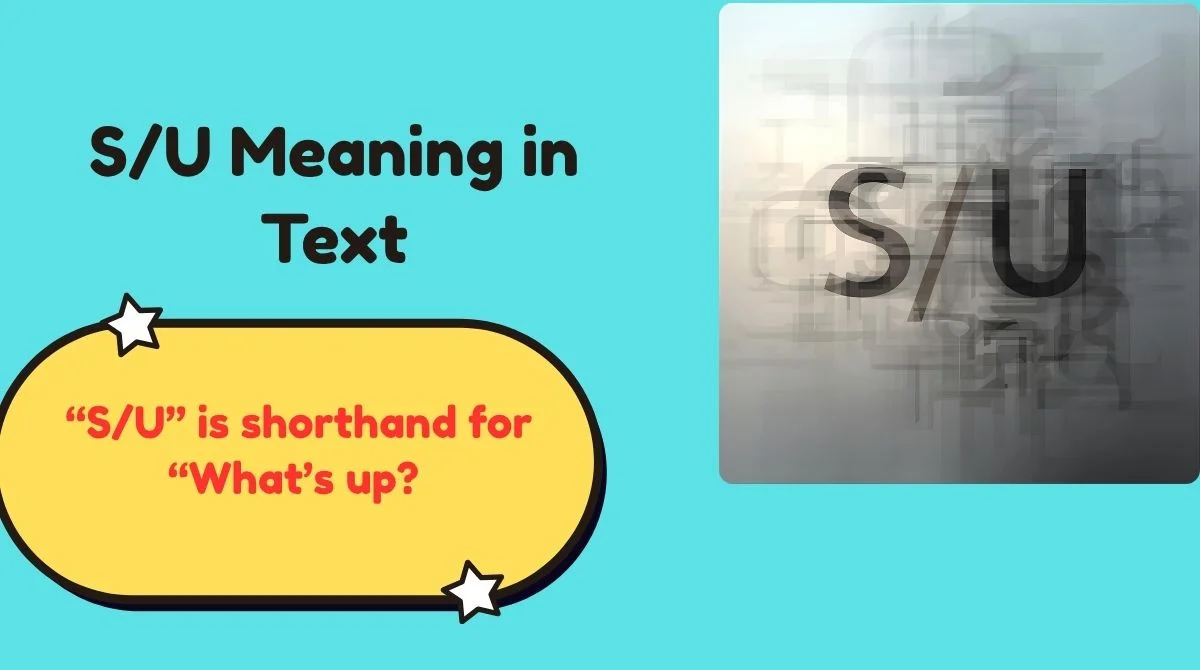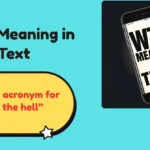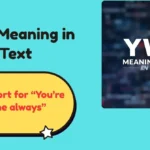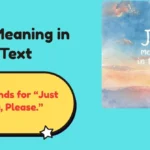Texting has become an art form, a way to connect quickly without the delays of a phone call. But sometimes, messages arrive with abbreviations that leave you scratching your head.
One of the most common yet confusing ones is “S/U.” If you’ve ever received a text saying “S/U” and paused, wondering what it means, you’re not alone.
This guide will break down the S/U meaning in text, its different contexts, how to respond, and even provide real-life examples for casual, professional, and playful settings. By the end, you’ll text back confidently without second-guessing yourself.
What Does “S/U” Mean in Texts?
Most of the time, “S/U” is shorthand for “What’s up?” It’s casual, friendly, and often used between peers, friends, or online acquaintances.
However, context matters. In professional settings, it might mean “Status Update,” asking for progress on a project. On social media, it can take on playful or trendy meanings, depending on the conversation and the platform.
Key Takeaways:
- Primary meaning: “What’s up?” – informal and friendly.
- Secondary meaning: “Status update” – professional or work-related.
- Tone dependent: Emojis, punctuation, and previous conversation clues help determine the exact meaning.
Common Contexts for “S/U”
The meaning of S/U shifts depending on the context. Let’s break it down.
| Context | Likely Meaning | Tone |
|---|---|---|
| Friend chat | What’s up? | Casual, friendly |
| Colleague / Team chat | Status update? | Neutral, professional |
| Social media | General check-in | Playful, trendy |
- Friendship & Casual Conversations: Texting your best friend or a peer? “S/U” usually means, “Hey, what’s going on?”
- Professional / Workplace Texts: In Slack, email, or Teams, “S/U” may ask for updates on a task.
- Social Media / Trendy Messaging: On platforms like Instagram or TikTok, it’s often playful, sometimes accompanied by GIFs, memes, or emojis.
Understanding the context helps you reply appropriately and avoid miscommunication.
Alternative Interpretations of S/U
While “What’s up?” is the most common, S/U can have other meanings:
- Sign Up: In certain contexts, like online apps or promotions.
- Set Up: Could refer to scheduling a meeting or event.
- Status Update: Often in work or project chats.
Tip: Always look at the tone, timing, and sender’s profile. A friend texting “S/U?” late at night likely wants to chat, while a colleague might want a project status update.
How to Respond to “S/U” Messages
Knowing the meaning is only half the battle. Your reply sets the tone for the conversation. Let’s categorize replies for different settings.
Professional Settings
When replying to colleagues, bosses, or clients, it’s best to stay neutral and concise. Avoid overly casual responses.
Examples:
- “Hi! Here’s the latest update on the project…”
- “Thanks for checking in. Everything is on track.”
- “I’ve completed the report and uploaded it to the shared folder.”
Pro tip: Avoid “Not much” or “Sup” in professional texts—it can come off as dismissive.
Polite & Formal Replies
Polite responses work for authority figures, teachers, or new acquaintances. Keep it courteous.
Examples:
- “Hello! I hope your day is going well. What’s new on your end?”
- “Good afternoon! I’ve been working on a few things. How about you?”
- “Hi! It’s nice to hear from you. Everything is going well on my side.”
Short, thoughtful sentences show respect without sounding stiff.
Casual or Friendly Replies
Texting friends or peers? Keep it light, simple, and natural.
Examples:
- “Hey! Not much, just chilling. You?”
- “Yo! What’s going on with you?”
- “Sup! Busy day or just relaxing?”
Adding emojis or GIFs can make your reply even more playful.
Playful or Trendy Replies (Social Media)
On platforms like Instagram or TikTok, people expect fun and witty replies. Memes, slang, or trending GIFs work perfectly.
Examples:
- “S/U? Living my best life 😎”
- “Just vibing. You?”
- “Sup! Just got done watching the latest TikTok trend 😂”
Trend-aware replies make the conversation feel current and fun.
15 Example Replies to “S/U” Based on Different Situations
Here’s a detailed list of replies you can adapt depending on the situation:
| # | Situation | Reply | Tone |
|---|---|---|---|
| 1 | Curious/Friendly | “Hey! Just working on some stuff, you?” | Friendly, casual |
| 2 | Supportive/Friendly | “Not much! How’s your day going?” | Warm, engaging |
| 3 | Casual/Playful | “Yo! Just chilling, you?” | Fun, relaxed |
| 4 | Interested/Professional | “Hi! I’ve completed the report. How about your updates?” | Professional |
| 5 | Appreciative/Polite | “Thanks for checking in! Everything’s good here.” | Polite |
| 6 | Inquisitive | “Sup? Got any fun plans today?” | Curious |
| 7 | Promotional Support | “Hey! Did you see our latest update? Check it out [link]” | Promotional |
| 8 | Neutral/Polite Decline | “Hi! I’m busy today but can catch up later.” | Polite |
| 9 | Tech-Aware/Friendly | “Sup! Just exploring the new app features 😎” | Casual, tech-savvy |
| 10 | Very Formal | “Good day! I’ve completed the tasks assigned. Please advise next steps.” | Formal |
| 11 | Excited/Fan-Based | “Sup! Just saw your latest post—amazing!” | Enthusiastic |
| 12 | Peer-to-Peer | “Hey! Not much, just hanging out. You?” | Casual, friendly |
| 13 | Influencer/Audience | “Thanks for reaching out! Check out our new content here: [link]” | Professional yet approachable |
| 14 | Unclear/Seeking Clarification | “Hey! Could you clarify what you mean by S/U?” | Polite, inquisitive |
| 15 | Humorous | “Sup? Just surviving Monday 😅” | Funny, casual |
Nuances of Tone: Choosing the Right Phrase
Tone can change everything. A single emoji or punctuation mark can shift your reply from friendly to sarcastic.
Tips:
- Use emojis carefully: 🙂 or 😎 can convey friendliness; 🙃 or 😅 can convey humor.
- Avoid ALL CAPS: It can come across as aggressive.
- Match the sender: If they are casual, reply casual; if formal, stay formal.
- Context matters: A late-night “S/U” may indicate a personal chat, while daytime might lean professional.
When NOT to Use “S/U”
Some situations call for caution:
- Professional emails: Avoid abbreviations unless your workplace uses casual internal messaging.
- Authority figures: Teachers, supervisors, or clients may not understand slang.
- Sensitive topics: Don’t use casual shorthand during serious discussions—it may appear dismissive.
FAQs About S/U Meaning in Text
What does S/U mean in text from a guy?
It usually means “What’s up?”—a casual way of checking in. Context matters.
Is S/U professional or casual?
It’s mostly casual but can mean “Status Update” in professional settings.
How should I respond to S/U?
Match your tone to the sender: casual with friends, polite/formal with colleagues.
Can S/U mean something else?
Yes, it can also mean “Sign Up” or “Set Up” depending on context.
Is it okay to use S/U in emails?
Not typically. It’s best reserved for texts or informal chat apps, not formal emails.
Conclusion
Understanding the S/U meaning in text is simple once you consider context, tone, and platform. Whether it’s a friend checking in, a colleague asking for a status update, or a social media interaction, your reply should fit the situation.
Use this guide to navigate casual, professional, and playful conversations confidently. Remember, the right tone makes all the difference.
By responding thoughtfully, you show awareness and social intelligence. Keep your messages friendly, concise, and context-appropriate. The next time you see “S/U,” you’ll know exactly what to type back.











